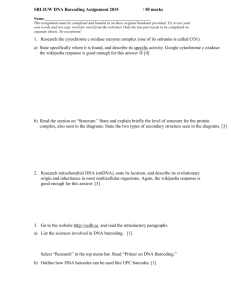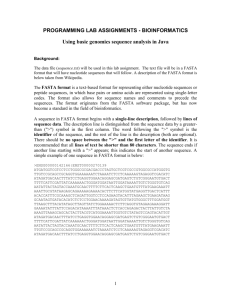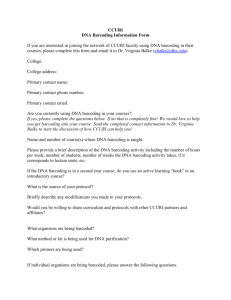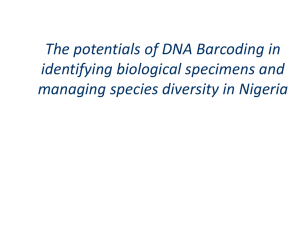SBI 4UW DNA Barcoding Assignment 2014 / 50 marks
advertisement
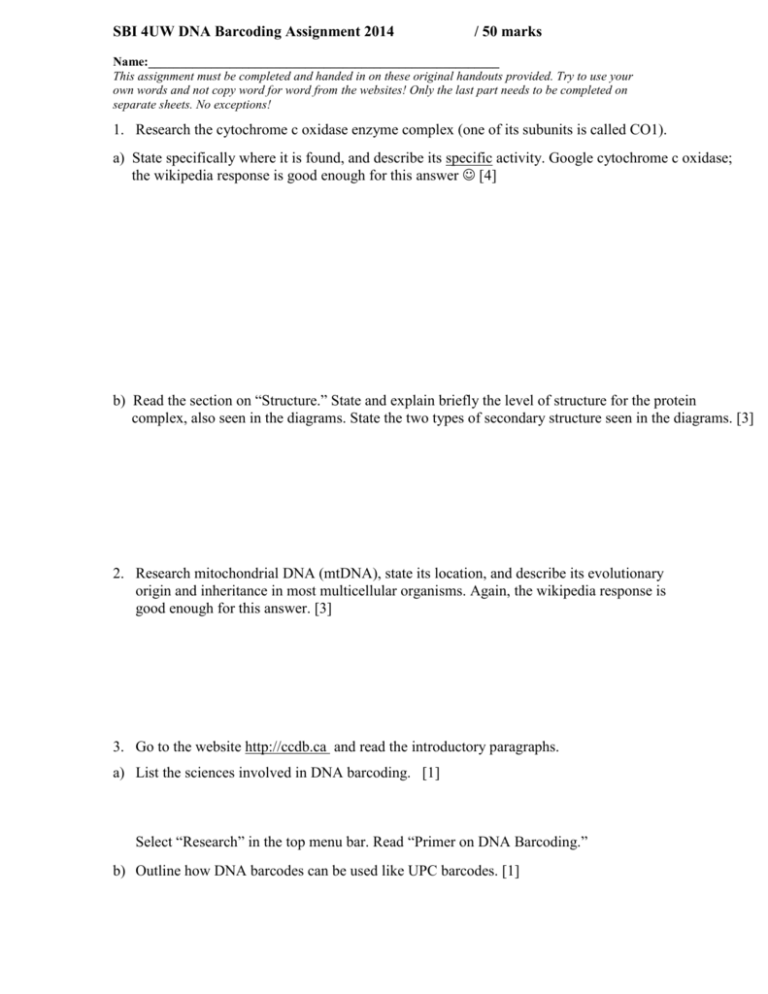
SBI 4UW DNA Barcoding Assignment 2014 / 50 marks Name:________________________________________________________ This assignment must be completed and handed in on these original handouts provided. Try to use your own words and not copy word for word from the websites! Only the last part needs to be completed on separate sheets. No exceptions! 1. Research the cytochrome c oxidase enzyme complex (one of its subunits is called CO1). a) State specifically where it is found, and describe its specific activity. Google cytochrome c oxidase; the wikipedia response is good enough for this answer [4] b) Read the section on “Structure.” State and explain briefly the level of structure for the protein complex, also seen in the diagrams. State the two types of secondary structure seen in the diagrams. [3] 2. Research mitochondrial DNA (mtDNA), state its location, and describe its evolutionary origin and inheritance in most multicellular organisms. Again, the wikipedia response is good enough for this answer. [3] 3. Go to the website http://ccdb.ca and read the introductory paragraphs. a) List the sciences involved in DNA barcoding. [1] Select “Research” in the top menu bar. Read “Primer on DNA Barcoding.” b) Outline how DNA barcodes can be used like UPC barcodes. [1] Scroll up to “International Barcode of Life (iBOL) and read the paragraph. c) State what iBOL participants will gather within 5 years. [1] Click on the title “International Barcode of Life (iBOL)” which opens a new website http://ibol.org. Go down to “Building the Barcode Library” and select “Learn more” d) State what BOLD stands for. [1] e) State what BOLD is used for. [1] Select “About Us” in the top menu bar and go to “What is DNA Barcoding?” f) Describe the gene region being used for DNA barcoding. [1] g) State the advantages of using CO1. [2] h) State why CO1 cannot be used in plants, and also state where genes that may be used for DNA barcoding have been located in plants. [2] Read “The Barcode Production Pipeline.” i) List the sequence of techniques used to obtain a DNA barcode from a tissue sample. [4] 1. 2. 3. 4. j) Using your knowledge from class, outline how the degeneracy of the genetic code plays a role in variation in protein coding gene sequences. [2] k) If 45 nucleotides are examined in a protein coding gene, and variation as described in j) above is possible in all codons, close to a billion alternatives could exist. Show how this amount of variation could theoretically be possible. [2] So why is all of this important? 1. Read the article provided DNA Barcoding: Cracking Down on Bushmeat on the CHCI website. To access the article, follow the same instructions given on the last page using step 4, except choose the article above to download instead of the fasta sequences. Explain how this technology may be used to stop the trade in illegal bushmeat and other animal parts. [3] 2. Suggest three other applications, not outlined on this assignment, for the use of DNA barcodes. A link at http://ccdb.ca at the bottom of the page for Species ID Services will help here. [3] Using the BOLD Systems to search for DNA barcodes and identify species: a hypothetical situation An individual is attempting to bring some feline pelts through customs into Canada. You have been assigned to find out if any of these may be endangered species, and if trade in the pelts is or may be illegal. 1. 2. 3. 4. Go to http://www.barcodinglife.org Select Identification in the top menu bar. Select the second bullet “Species Level Barcode Records.” The fasta sequences for two COI gene samples can be found at http://chc.wrdsb.ca; select “Academics” then “Science” then “(your teachers name)” then “SBI 4UW” then choose the location on the webpage indicated by your teacher in order to download the fasta sequences. 5. For the first sample, copy and paste the first sequence into the box where it states Enter sequences in fasta format. 6. Select Submit. 7. This will open an Identification Summary for the fasta sequence submitted. Complete the following table for the first sample. Repeat the process for the second fasta sequence. [2 each = 4 total] Table 1. Identification Summary for the first fasta sequence and probability of placement Taxonomic Level Taxon Assignment Probability of Placement phylum class order family genus (use proper format!) species (use proper format!) Table 2. Identification Summary for the second fasta sequence and probability of placement Taxonomic Level Taxon Assignment Probability of Placement phylum class order family genus (use proper format!) species (use proper format!) 8. Research the common name of each animal, where it lives, and its status (whether or not it is endangered). Explain if trade for this pelt would be legal or not. This should be done on a separate piece of paper, and organized separately for each species identified above. [4 marks for each species = 8 total] References should be used for these answers. [1] 9. Explain if the wolf (Canis lupus) and the domestic dog (Canis familiaris) are possibly the same species. Provide concrete evidence in the answer from the BOLD systems. Complete this answer below. [3]
